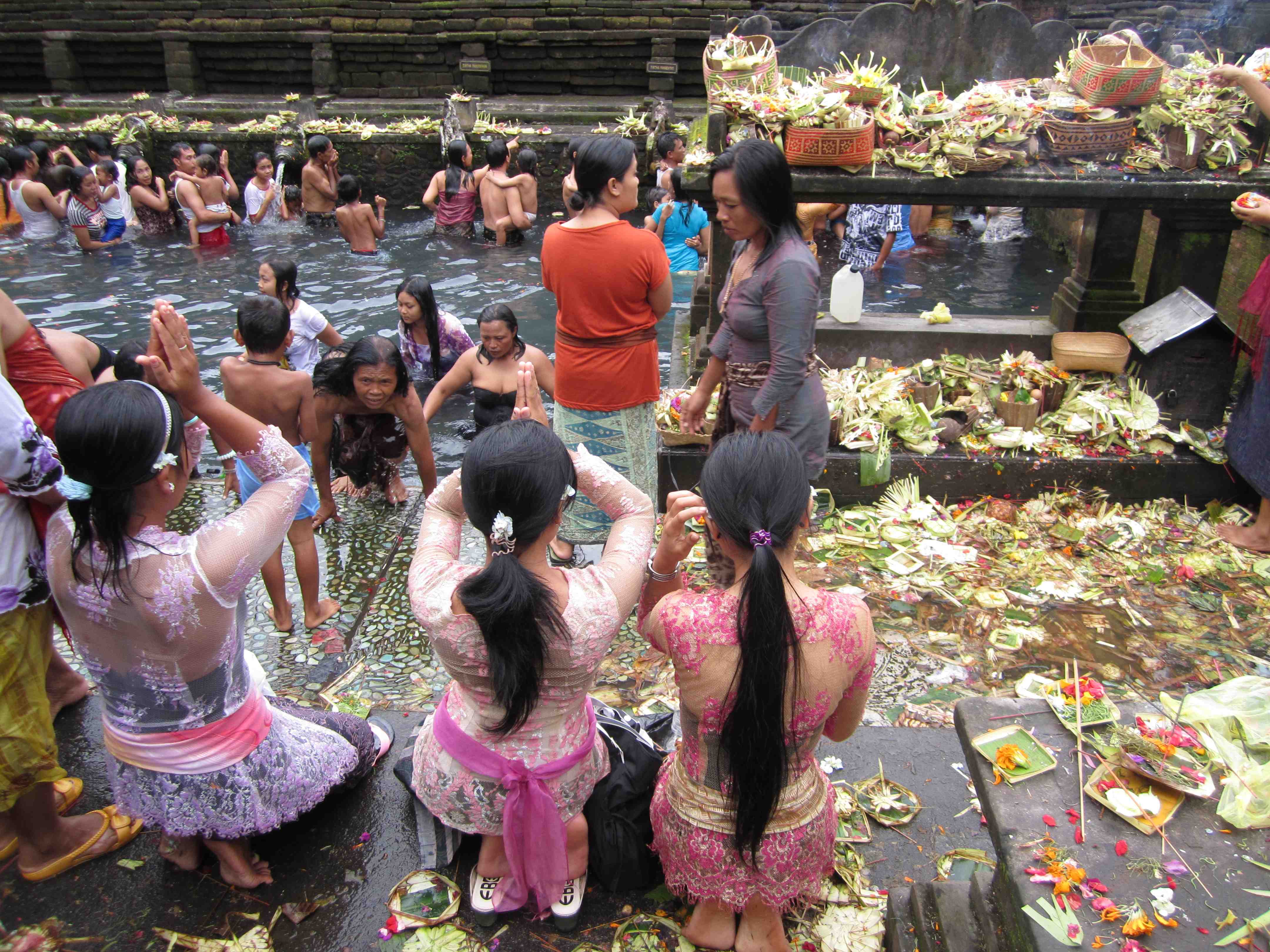
by Erin
Among the over 17,000 islands in Indonesia, Bali has a truly singular culture. Over 93% of the population is Balinese Hindu, a strain of Hinduism quite distinct from Indian Hinduism. Balinese Hinduism is a syncretism of traditional Indian Hinduism and the animistic spirituality that has characterized Bali for thousands of years. For instance, while the Balinese recognize the three primary avatars of Brahman (Brahma, Vishnu, and Shiva), it is more common to see Balinese Hindu shrines and tiny stone thrones bereft of any statues, highlighting the Balinese people’s overriding devotion to nature rather than more tangible deities.
On Saturday our Bali Globalist team somewhat unwittingly found itself at the center of Balinese cultural life upon traveling to Pura Tirta Empul, one of Bali’s most important Hindu temples. Constructed in AD 962, the temple is famous for its springs and bathing pools that purportedly contain water with magical powers. As we approached the temple, hoards of people were congregating on the roads, arranging themselves into processional lines that seemed to run without end as we cruised along the sinuous roads outside of Ubud. Men donned udeng, head cloths, and wore batik sarongs accented with cloth sashes. Women displayed delicate lace tops with similar batik sarongs. Both sexes wore small flowers behind their ears and adhered small clumps of white rice to their foreheads and temples. Vibrantly colored barongs, good monster characters in Balinese Hindu folklore, strutted alongside the crowds. We soon found out from our driver that we had serendipitously come to Pura Tirta Empul on Kuningan, the last day of the 10-day Galungan period. During this period ancestors descend to their former homes and must be welcomed and entertained through prayers and offerings.

Fashioning our own sarongs, many of which had been purchased earlier in the day, we were soon swept up by the throngs of people at the temple who were all eagerly shuffling to the magical baths. Just a handful of tourists dotted the pack, providing us with a truly immersive experience. Approaching the bath, we could find just enough space to peak through the stone gate’s entryway and see an endless stream of people jumping into the bath and joining in the slow walk around its perimeter, which was lined with water spouts of holy water that each adherent would stop and wash under. Sidling away from the bath, we entered the central praying area of the temple. (Note: If you are a female on your period, you are not permitted to enter the temple, similar to other religions’ practices.)
We were greeted by the unending peal of a single bell that rang throughout most of the prayer service, which also seemed to run continuously. Men and women kneeled with their hands pressed together near their foreheads. A holy man walked throughout the crowds splashing holy water on worshipers’ heads. All were kneeling in front of an empty stone throne, where overflowing baskets of offerings had been placed as a gift to the ancestors. Apples, pears, pastries, rice cakes, and even the occasional fried chicken composed this ancestral feast.
Riveted by the dynamic nature of the Kuningan celebration, we decided to explore another nearby temple called Gunung Kawi. Gunung Kawi is primarily known for its ten candi, eight meter high shrines cut out of the rock face in imitation of regular statues. While the candi were certainly a sight to behold, it was the magical ambience at the temple and the scenic–and fairly arduous–trek to and from the temple that truly colored our experience there.

Conquering the roughly twenty different flights of stone steps that wound down the mountain, full of lush rice paddies and rivers, we were soon engulfed by crowds of local women also descending the mountain. With incredible grace, these women effortlessly balanced the same metal bowls of offerings that we had seen at Tirta Empul. They were always smiling yet never took their eyes off of their particular focus point, so as to maintain balance, even when passing us. Following these women to the central temple, we found that hundreds of the offering bowls were being placed one after another wherever an open space could be found on the temple’s stone ledges. Women that had already brought the families’ offerings were sitting around the edge of the temple, and the men were slowing streaming in for the service, which was to take place in a half hour. We were only met with friendly gazes and sweet welcomes as we passed through the temple.
As we further explored the surrounding areas, we entered a surreal world of unending foliage and waterfalls. It soon became quite clear why Bali had never shed its animistic devotion to nature; there was an awe-inspiring sense of harmony that existed between our natural surroundings and the Hindu temple nearby. This seamless flow left us all feeling very fulfilled by the end of the day, as we not only were able to observe the Balinese culture firsthand but also were able to embed a bit of the Balinese Hindu philosophy within ourselves.
Main image: Women and families pray and cleanse themselves at the bathing pool of Tirta Empul.